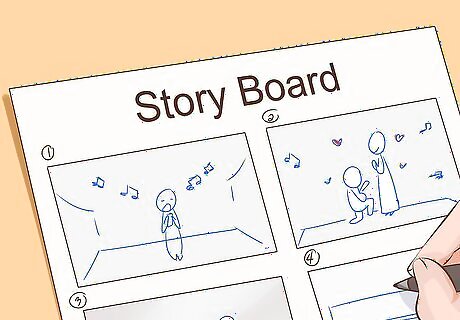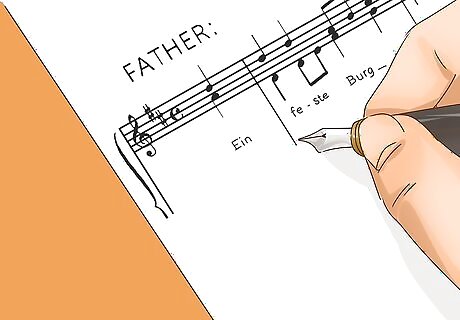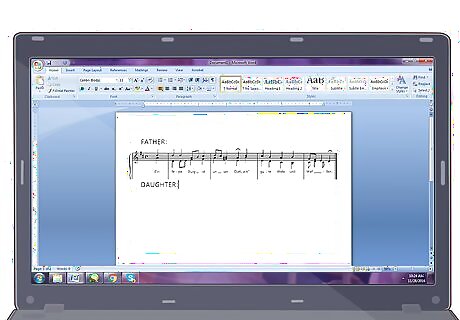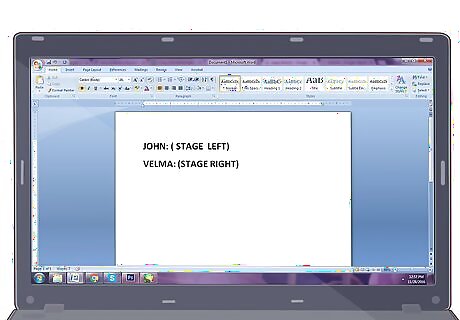
views
Starting the Musical

Brainstorm ideas. Start by sitting down and writing out a few ideas for the story. Think about a question or problem you can address in the musical, such as “What is love?” or “How does it feel to be an outsider?” You can also think about a personal experience that upset you, unsettled you, or made you question your values. This experience could serve as inspiration for your musical. Consider why an idea might work better in the musical format than in the short story or novel format. Music and singing need to feel necessary to the story idea in some way. For example, you may realize that you can only tell the story of your parents’ meeting in New York in the 70s through the music they loved in that time period. You may also try going for a walk in a park or sitting in a public square to get inspiration. Watch people interact and notice any behaviors or actions that seem interesting to you. You could then create a storyline based on the lives of other people in your everyday life. Try to choose a story idea that you are truly passionate about. Having a story that you really care about can help you stay motivated to write the musical and see it performed one day on stage.

Create a one line story summary. Once you have a story idea, you should try to create a one line summary so you have a clear sense of the story. Try to answer the question, “What is the story about?” Focus less on character names and more on the dramatic moment in the main character’s lives that create the story. For example, a one line story summary for the musical Fiddler on the Roof could be, “A Jewish peasant tries to marry off three of his daughters and deal with anti-Semitic values that threaten his village and their way of life.” This summary includes the major plot points and also includes key themes, such as a “way of life” and “anti-Semitism”, that play out in the musical.

Study other musicals for inspiration. To get inspiration for your musical and come up with a story idea, you should study other musicals. Go to musicals, read musicals on the page, and study the ways in which they combine song, music, and dialogue to create an effective show for the audience. You may read and watch a production of several classic musicals, including: Cats Fiddler on the Roof The Phantom of the Opera My Fair Lady Sweeney Todd Guys and Dolls Hamilton The Greatest Showman Into the Woods Dear Evan Hansen Wicked
Writing the Musical

Determine the emotional core of the story. Once you have the story idea, think about what is at the heart of your story. Ask yourself, “What are the themes in the story?” “What larger issues does the story address?” Identifying the emotional core of the story will help you focus your writing and create content that addresses the emotional aspect of the musical. For example, the musical Sweeney Todd is, at the surface, about a Victorian barber out to kill the men who stole his wife and sent him to prison on false charges. But at the heart, the musical is about the high cost of revenge and how anger and resentment can ruin your present day life. I fell in love with musicals from the first rehearsal I went to. "Over the past year, I have decided that I want to go to college for musical theater. I have also come up with an idea that means a lot to me, and I want to take it to the stage. The only problem was that I didn't know how to, and this article told me how! Now I have a clear idea of what I need to do and I am able to get my dream started." - Hannah B. I wanted my story to make a big impact. "I started off writing short stories and screenplays, but after joining the stage crew, I fell in love with theater. I had been thinking about writing a story about a Russian immigrant but realized that it might make a bigger impact as a musical. This was hard at first because even though I had experience singing and playing the piano, I had no experience writing music. However, after a year, I finished it and am so proud of the final product." - Elijah R. Did you know that wikiHow has collected over 365,000 reader stories since it started in 2005? We’d love to hear from you! Share your story here.

Make storyboards. One way to help you write a musical is to create storyboards or visual representations of each scene. You can draw on regular sheets of paper or get larger paper to write on. Storyboarding each scene can help you get a better sense of your character’s actions and motivations. It can also make it easier to write the music and the songs. You may try writing down a rough list of scenes and then creating storyboards for each scene. Try to get the essential visual elements for each scene on the storyboard. Don’t be afraid to use many storyboards for each scene, as the more detailed you are, the more depth the musical will have.

Write the music. The most important element of a musical is the score. There are four types of musicals: all-sung, operas, integrated, and unintegrated. Musicals that are all-sung means there is no dialogue at all and the entire script is sung. Operas are also all sung. The most popular form is integrated, where the music and the dialogue are integrated together in one show. If you have written music before, you may try writing music for each scene that you have storyboarded. Or you may start by writing one to two pieces that you feel are key, such as the theme for the show. You may also try using music writing software on your computer that helps you translate humming, singing, or whistling into written music. This may be ideal if you have never composed music before but are musically inclined and want to somehow translate your ideas into a score.

Create the lyrics for the songs. You may be able to write the music and the lyrics, especially if you know the story well and feel confident about your music writing abilities. If you are not musically inclined, you may look for a writing partner who is skilled at composing music for the stage. Many musicals have been written in pairs or teams, with one person writing the music and one person writing the lyrics. Once you have written the music, you should create a list of songs. Notice if you have more songs than scenes. Having many songs is not a bad thing, but you want to be sure that the musical flows well from dialogue to song and from scene to scene.

Put the music and the story together. Organize the musical so there are scenes, music, and lyrics in the same document. Order the music within the scenes so it all feels cohesive and well put together. Check that you have smooth transitions from spoken dialogue to a song. For example, you may notice that you have a scene between a father and daughter, followed by a song that is sung by the daughter. You should make sure the song relates somehow to the scene and that the daughter addresses her relationship with her father in the song. This will make the musical flow smoothly.
Polishing the Musical

Run through the musical. Do this on your own or with a friend. If possible, get access to a piano or an instrument that is important in the musical's score. Then, read all the dialogue out loud and sing the songs to the tune of the instrument. Notice how the dialogue and the songs sound aloud. Pay attention to any dialogue that feels confusing or clumsy. Check that the songs relate to the dialogue in someway and sound polished. You may underline or mark any sections that feel off to you. You can then go back and revise them so until they are at their best.

Add in stage directions. Stage directions tell the actors where they are situated on stage and how they are approaching a scene or a song. Keep the stage directions concise and to the point. Do not include stage direction that feels long winded or convoluted. For example, if you want to notate that there is going to be a number in a scene, you would add in “Music starts playing (insert musical number here)” into the script. This will signal to the actors that a song is going to be performed. You should also include details about where the actors enter from into a scene, such as STAGE RIGHT or STAGE LEFT. You should include notes about a character’s reaction, but only if it is an important reaction in the scene. For example, “VELMA (aghast) How could you do that?” or “JOHN (crying) I can’t sing anymore.”

Get actors to perform the musical. Once you have a polished script, you should try to have it performed on stage. You may contact actors in your area and hire them to perform the musical at your local theater. Or you may try to get the musical performed by a prominent theater company in your area. You may also seek out actors and playwrights who have had success to get advice on how you can get your musical produced.




















Comments
0 comment